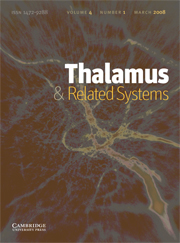Article contents
Visual stimuli modulate precise synchronous firing within the thalamus
Published online by Cambridge University Press: 04 January 2008
Abstract
The work of Mircea Steriade demonstrated that the neocortex could synchronize large regions of the thalamus within 10−100 msec. Unlike the synchrony generated by the cortex, the retinal afferents synchronize a restricted group of neighboring thalamic neurons with <1-msec precision. Here, we use a large sample (n = 372) of simultaneous recordings from neighboring neurons in the lateral geniculate nucleus (LGN) to illustrate the high specificity of the synchrony generated by retinal afferents and its dependency on sensory stimulation. First, we demonstrate that cells sharing a retinal afferent show a balanced receptive field diversity: although slight receptive field mismatches are common, the largest mismatches in a specific property (e.g. receptive field size) are restricted to cells that are precisely matched in other properties (e.g. receptive field overlap). Second, we show that these receptive field mismatches are functionally important and can lead to a 5-fold variation in the percentage of synchronous spikes driven by the shared retinal afferent under different stimulus conditions. Based on these and other findings, we speculate that the precise synchronous firing of cells sharing a retinal afferent might serve to amplify local stimuli that might be too brief and small to generate a large number of thalamic spikes.
- Type
- Original Articles
- Information
- Copyright
- Copyright © Cambridge University Press 2008
References
REFERENCES
- 8
- Cited by


